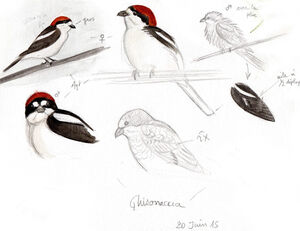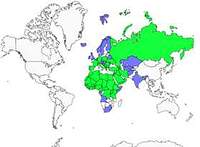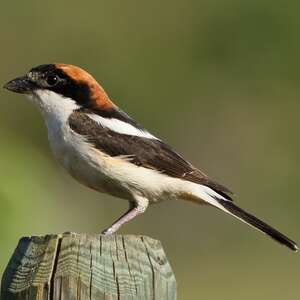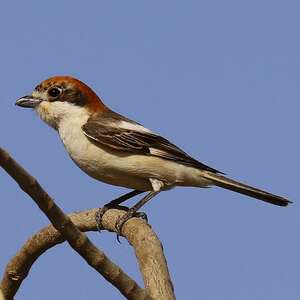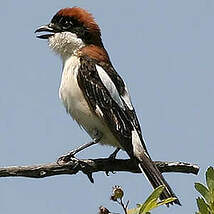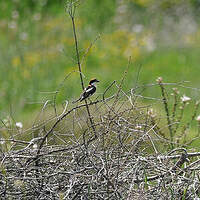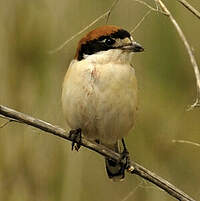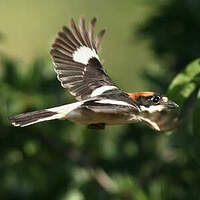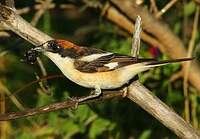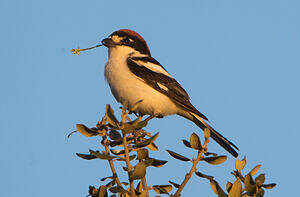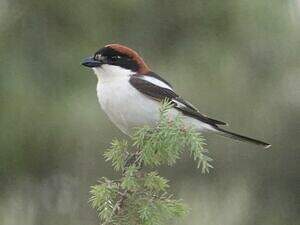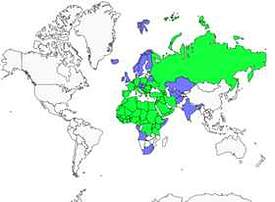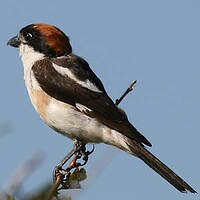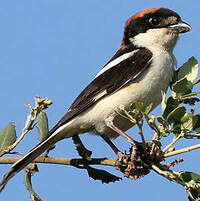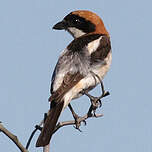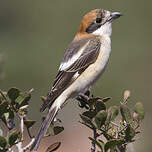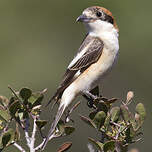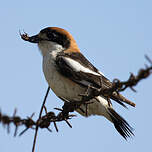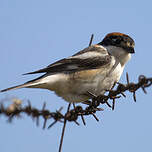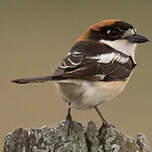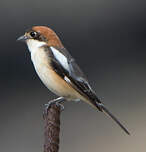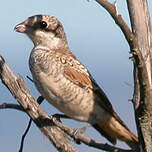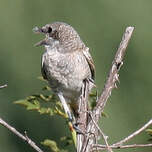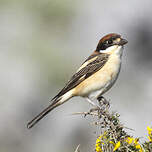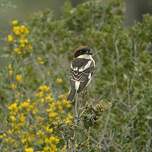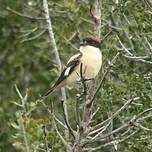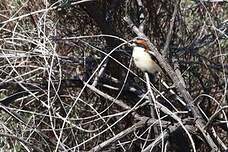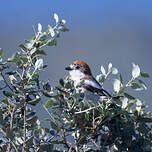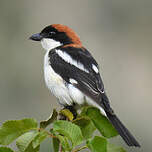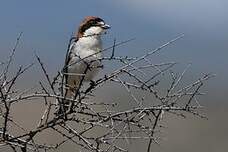Woodchat Shrike
Lanius senator - Pie-grièche à tête rousse
Identification
The Woodchat Shrike is slightly larger than the Great Grey Shrike. As its name suggests, it is easily recognized by the reddish-orange colouring of its crown and nape in a very visible and typical mark that a little bit spills over the top of its mantle. It is the only shrike to have such a coloured patch. This patch is surrounded by black that is in stark contrast, black that occupies the forehead, the eye and ear areas and that ends in a point on each side of the neck down to the mantle. There is a slight sexual dimorphism. Males are more vibrantly coloured and in stronger contrast than females that show white on the forehead, on the lores, around the eye, white that even forms a faint eyebrow. It can happen that males have a little bit of white on their forehead towards their beak.
The contrast between its superior, very dark, black and brown-black parts and its inferior, lighter, barely cream-colored parts when new and with a touch of rufous, especially on its flanks and all white when worn is big. On average the contrast between its superior and inferior is stronger on males. On the mantle, it is bordered by white scapulars and its wings show a white area at the base of arms. The rump and the greater under-tail coverts are white. The tail is black with white outer rectrices and a little bit of white at the end of the tail. All this is visible in flight and is a sign of the species. Beak and legs are black. The eye's iris is almost black.
The juvenile is very different. It looks a bit like the young Great Grey Shrike, but with less red and more contrast. It can be recognized mainly by its narrow white scapulars that are bordered by brown, and form a spot like on adults, and a little bit of white at the base of the primaries. On its superior and inferior, the plumage has a scaly appearance. The beak is blackish, the eye and its legs are black.
Subspecific information 3 subspecies
- Lanius senator senator (c and s Europe, n Africa)
- Lanius senator badius (w Mediterranean Is.)
- Lanius senator niloticus (Cyprus and s Turkey to Iran)
Foreign names
- Pie-grièche à tête rousse,
- Alcaudón común,
- picanço-barreteiro,
- Rotkopfwürger,
- vörösfejű gébics,
- Roodkopklauwier,
- Averla capirossa,
- rödhuvad törnskata,
- Rødhodevarsler,
- strakoš červenohlavý,
- ťuhýk rudohlavý,
- Rødhovedet Tornskade,
- punapäälepinkäinen,
- capsigrany comú,
- Trjásvarri,
- dzierzba rudogłowa,
- sarkangalvas čakste,
- rjavoglavi srakoper,
- Красноголовый сорокопут,
- ズアカモズ,
- 林䳭伯劳,
- rödhuvad törnskata,
- 林鴝伯勞,
Voice song and call
The call is a tec which is somewhat similar to a chaffinch call but much louder. The tec can turn into a tiec. When alarmed, it gives out soft heinnn murmurs, rapid tatatatac and other various cries. The song is a not-so-loud babble typically characteristic of a Woodchat Shrike which consists of phrases reminiscent of Sylvidae or Turdidae and includes imitations of other species' calls. It can be confusing if one does not observe the singer.
Habitat
Woodchat Shrike is a bird of the sun. On its breeding grounds, two landscape elements are important, an open tree-laced area with plenty of space between trees and equipped with perches, and a not too densely vegetated and insect-rich ground for hunting.
Behaviour character trait
Flight
The typical flight of the Woodchat Shrike is low and direct from one perch to another, with rapid wing beats. The bird is easily recognised by its dark upperparts which are contrasted by the white scapulars, primary, rump and tail which are not found with any other European bird.
Dietfeeding habits
Like other Shrikes, the Woodchat Shrike is a sight hunter, who hunts from a perch dominating the hunting ground and dives on its prey. It is mainly insectivorous due to its size and hunts for large terrestrial insects wandering day on the ground or flying at low height, various coleoptera, orthoptera, hymenoptera and lepidoptera mostly, but also other arthropods such as spiders or small molluscs according to opportunities. It seems that it impales its surplus prey little.
Reproduction nesting
This species is monogamous and territorial. It arrives in breeding sites depending on the latitude, at the end of March in Israel or North Africa for example, in April further north such as in Spain or the south of France and until May in the most northern territories.
It is a species of the plains and of medium altitude in the south of its range.The couple builds the nest, a compact cup made of intertwining rods and roots held together by spider webs and filled with fur or feathers. It is placed on a lateral branch of a small tree. The laying is of 5 eggs on average, light beige eggs, spotted with grey and brown at the big end. It is incubated by the female for 15 days, the male supplying her with food. The chicks are incubated by the female during the first days. They will stay in the nest for another 15 days, fed by both adults. After the flight, they will stay at the site under the dependency of the adults for approximately 6 weeks more before they emancipate. In Europe, there is only one clutch per season. The reproductive success seems to be low, the literature speaking of 42 young ones at the flight out of 100 eggs laid. Replacements layings are frequent in case of premature destruction of the clutch.
Geographic range
Woodchat Shrike mainly occupies Mediterranean countries, except for Egypt. It is well represented in Maghreb countries, in Spain, in Southern France, Italy, in the South of Balkan Countries, in the West and South of Turkey, the Caucasus, and the Middle East. It can also be found in Iraq and Iran, occasionally. It is present but not common in the northeast of France and the south of Germany. It winters in Africa south of the Sahara in a wide belt from Senegal to Ethiopia. Its wintering range goes as far as Gabon and north Kenya.
Threats - protection
IUCN conservation status
concern
in the Wild
threatened
evaluated
Although its number is decreasing, the Woodchat Shrike species is not yet endangered and remains quite common in its strongholds. Nevertheless, its future is not necessarily reassuring. There is already the evolution of the climate, the climate change as we are used to saying, which has an impact on the vegetation and, consequently, on the associated entomofauna.
Man's action on the environment can also be detrimental to it. The intensification of agricultural and forestry practices, with the use of pesticides, deprives it of part of its habitat and its resource in insects. An example: strict pruning of fruit trees and ploughing of production orchards are obviously detrimental to it. Uncontrolled occasional fires that may affect its territory are perhaps the worst thing that can happen to it.
If we add to this the problems it inevitably encounters in its wintering area, there is cause for concern about it.
Sources of information
- IOC World Bird List (v14.2), Gill, F and D Donsker (Eds). 2024-04-18.
Other sources of interest
 Specification sheet created on
25/07/2023 by Jean François
Specification sheet created on
25/07/2023 by Jean FrançoisTranslation by AI Oiseaux.net
© 1996-2025 Oiseaux.net
- Accipitriformes
- Aegotheliformes
- Anseriformes
- Apodiformes
- Apterygiformes
- Bucerotiformes
- Caprimulgiformes
- Cariamiformes
- Casuariiformes
- Charadriiformes
- Ciconiiformes
- Coliiformes
- Columbiformes
- Coraciiformes
- Cuculiformes
- Eurypygiformes
- Falconiformes
- Galliformes
- Gaviiformes
- Gruiformes
- Leptosomiformes
- Mesitornithiformes
- Musophagiformes
- Nyctibiiformes
- Opisthocomiformes
- Otidiformes
- Passeriformes
- Pelecaniformes
- Phaethontiformes
- Phoenicopteriformes
- Piciformes
- Podargiformes
- Podicipediformes
- Procellariiformes
- Psittaciformes
- Pterocliformes
- Rheiformes
- Sphenisciformes
- Steatornithiformes
- Strigiformes
- Struthioniformes
- Suliformes
- Tinamiformes
- Trogoniformes

